Cotton can overcome many stresses and produce profitable lint yields when the crop gets off to a good, uniform start. So, when is the “best” time to plant cotton to meet those criteria? In a thermally-limited environment for cotton, such as Kansas, we know we need to plant as early as possible to maximize yield potential. However, those extra heat units from early planting are only useful if you have a stand of plants to benefit.
First, much as with corn, the goal is to achieve an acceptably uniform and optimal stand. The recommended window for cotton planting is relatively narrow compared to that for other summer crops grown in Kansas – roughly May 1 through June 5. However, it is best to monitor soil conditions rather than the calendar. You can monitor soil temperature information on the Kansas Mesonet (http://mesonet.k-state.edu/agriculture/soiltemp/). The Mesonet data can provide a good general idea of soil temperatures and trends. However, a farmer should also monitor actual field conditions at seeding depth, as differences in residue, moisture content, and other factors can result in temperatures that differ from those observed at the local Mesonet station. For various reasons, including seedling chilling, potential herbicide injury, thrips, and seedling diseases, it pays to plant when growers can get an adequate stand and when the crop will grow vigorously.
Soil temperature and the 10-day forecast are two major factors that contribute to that fast start. Cotton seed germination and early growth/emergence are favored by soil temperatures above 64°F and adequate, but not excessive, soil moisture. Based on USDA-ARS research work at Lubbock, TX, seedling cotton requires more than 100 hours above 64°F at the seed level to emerge.
Soil Temperatures – Current, Departure from Normal, and Forecast
We often use 60°F at planting depth in Kansas as our baseline temperature. As of April 18, much of the state's southern portion was at/near that threshold after very warm temperatures the last week (Figure 1). However, the air temperatures are expected to be much moderated and cooler in the next few days. Soils for all but the northeast are quite dry, with many locations below 50% saturation (Figure 2). This will result in quickly changing soil temperatures. However, the cooler weather is expected to be brief, with a return to warmer-than-normal expected at the beginning of May (Figure 3). There are hints that moisture will also be on the rise into early May which may help establish more stable soil temperatures as we approach peak planting.
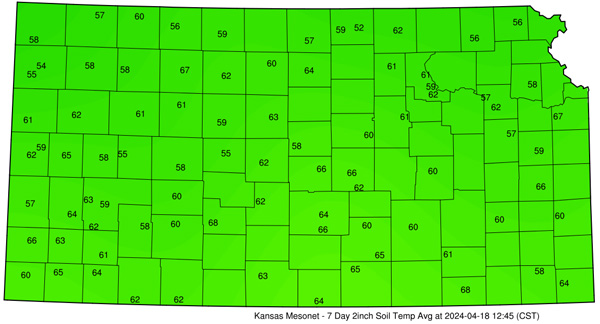
Figure 1. Average 7-day 2-inch soil temperatures (°F) as of April 18, 2024. Data and image courtesy of Kansas Mesonet (mesonet.k-state.edu).
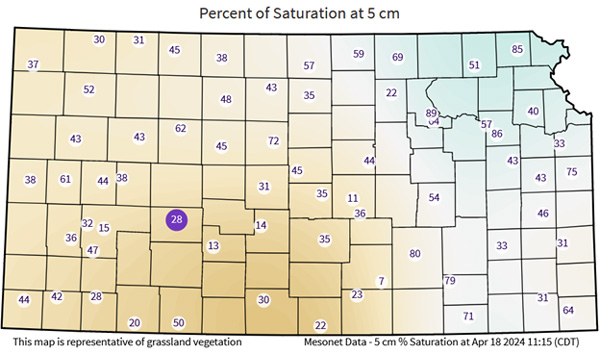
Figure 2. Percent of saturated soil at the 5cm depth on the Kansas Mesonet as of April 18, 2024. Data can be found here: mesonet.ksu.edu/agriculture/soilmoist/
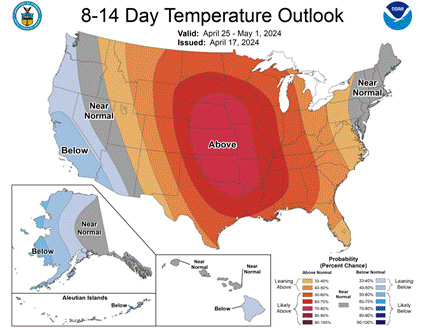
Figure 3. The Climate Prediction Center’s 8 to 14-day temperature outlook for the period April 25-May 1, 2024. Source: cpc.ncep.noaa.gov.
In addition to considering soil temperature, growers should plant high-quality varieties (e.g., those with high cold germination and large seed size, good cold tolerance, and early-season vigor ratings).
Information from North Carolina State University’s cotton web page illustrating the importance of heat unit accumulation immediately following planting is shown in Table 1.
Table 1. Relationship between predicted DD-60s and Planting Conditions (Source: North Carolina State University, https://cotton.ces.ncsu.edu/)
|
Predicted DD-60 accumulation for five days following planting |
Planting conditions |
|
10 or less |
Very Poor |
|
11 – 15 |
Marginal |
|
16 – 25 |
Adequate |
|
26 – 35 |
Good |
|
36 – 49 |
Very Good |
|
50 |
Excellent |
|
Avoid planting cotton if the low temperature is predicted to be below 50°F for either of the two nights following planting or predicted daily DD-60s is near zero for the day of planting. |
|
Effects of cold soil on cotton seeds
Cotton seed exposed to cold for the first 2-3 days after planting, OR when the seed is imbibing moisture from the soil, is susceptible to imbibitional chilling injury. The greatest sensitivity is during the first day after planting, when water is being imbibed (Hake et al.), as shown in Figure 4.
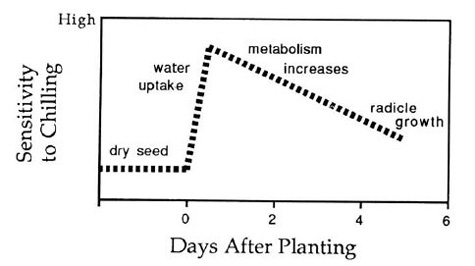
Figure 4. Relative sensitivity of cotton to chilling in the first several days after planting. K. Hake, W. McCarty, N. Hopper, and G. Jividen.
Cotton seeds contain lipids, which must be converted to energy, and cell membranes must develop properly. Seedlings may suffer damage if soil temperatures drop below 50°F during this critical germination period. The first 30 minutes after planting, the seed will absorb up to 60% of the water necessary for germination. Cold soil temperatures (<45°F to 50°F) will most likely lead to injury or seedling death. Damage may result in malformed seedlings, loss of or damage to the taproot, and a greater likelihood of seedling disease problems. Injury usually kills the root tip meristematic tissue, stopping normal taproot growth and leading to lateral root development (Figure 5). If the plants survive, the root system will not develop normally. Additionally, reductions in yield have been documented when less than 25 heat units are received in the first 5 days after planting. For these reasons, it’s critical that cotton be planted into a warming soil temperature trend.
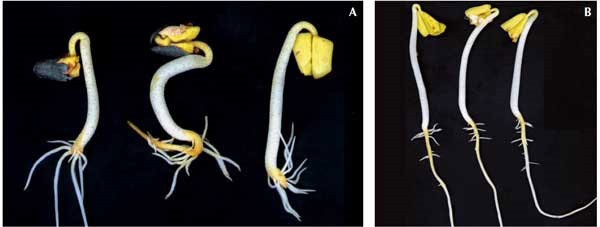
Figure 5. Cotton seedlings subjected to chilling temperatures (A) compared to seedlings not chilled (B) during imbibition from a study conducted by Hopper and Burke. Note the absence of normal taproot growth of the seedlings in A. Seedlings in A and B were exposed to the same temperature (86°F) with the exception of the first six hours of imbibition in which seedlings in A were exposed to chilling temperatures of 40°F. Photos by N. Hopper, Texas Tech University and J. Burke, USDA-ARS, Lubbock, TX.
Seed Quality
Cotton production in Kansas is typically thermally limited, with slower warming in soil temperatures and higher surface residue levels than other cotton-growing areas. It is especially important that producers plant cotton seeds with exceptional seed quality and understand both their warm and gold germination scores on their seed lots.
Warm germination scores are standardized across the industry and are legally required on seed tags. Cold germination tests are not required by law but are available from reputable seed companies. Be cautioned that cold germination test procedures are not necessarily uniform across companies. Be sure to ask and understand what methodology was used before comparing cold germination scores across companies. Generally, the cold germination test for cotton should be conducted at 64.4 degrees, with that temperature held constant for seven days. To be counted as germinated, the seed must sprout, and the radicles of the sprouted seed must reach at least 4 cm in length. However, the results for the cold germination test are not nearly as repeatable as those of the warm test, which is a primary reason why there is no legal standard for cold germination. Producers should plan to plant cotton seeds with the highest cold germination scores first. Cold scores greater than 85% are generally preferred for early planting.
Some companies may be able to provide the Cool-Warm Vigor Index (CWVI) score for their seed. This test, developed in Texas, gives a score that is the combined percentage of the 4-day warm germination test and the cool germination test. Scores of 160 or greater are excellent, Good = 140-159, Fair = 120-139, and Poor = anything less than 120. Farmers would first want to plant seeds with the highest scores and move to lower-scoring seed lots as soil temperatures increase.
References
R. Boman and R. Lemon. 2005. Soil Temperatures for Cotton Planting. AgriLIFE Extension. Texas A&M System. http://cotton.tamu.edu/General%20Production/scs-2005-17%20Soil%20Temp.pdf
G. Collins: Interpreting Warm and Cool Germ of Cotton Seed and Understanding How Each Should Be Used (Collins, Edmisten, and Foote) http://go.ncsu.edu/readext?931611
K. Hake, W. McCarty, N. Hopper, and G. Jividen. 1990. Seed Quality and Germination. Cotton Physiology Today. https://www.cotton.org/tech/physiology/cpt/variety/upload/CPT-Mar90-REPOP.pdf
B. Robertson, S. Stewart, & R. Boman. 2007. Planting and Replanting Decisions. Cotton Physiology Today. https://agrilifecdn.tamu.edu/lubbock/files/2011/10/cptvol13no12007.pdf
Lucas Haag, Northwest Area Agronomist
lhaag@ksu.edu
Logan Simon, Southwest Area Agronomist
lsimon@ksu.edu
Chip Redmond, Kansas Mesonet
christopherredmond@ksu.edu
Tags: weather cotton soil temperature seed quality planting conditions